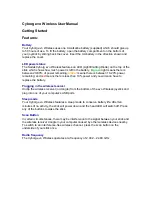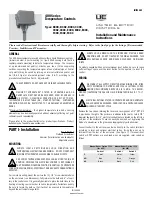
3.4.2 Line Fuse and Fuse Holder
31
|
www.lakeshore.com
AC line voltage is set at Lake Shore, but it is good to verify that the AC line voltage indica-
tor in the fuse drawer window is appropriate before turning the instrument on. The
instrument may be damaged if turned on with the wrong voltage selected. Also remove
and verify that the proper fuse is installed before plugging in and turning on the instru-
ment. Refer to section 8.5 for instructions on changing the line voltage configuration.
3.4.2 Line Fuse and
Fuse Holder
The line fuse is an important safety feature of the Model 335. If a fuse ever fails, it is
important to replace it with the value and type indicated on the rear panel for the line
voltage setting. The letter T on the fuse rating indicates that the instrument requires
a time-delay or slow-blow fuse. Fuse values should be verified any time line voltage
configuration is changed. Refer to section 8.6 for instructions for changing and verify-
ing a line fuse.
3.4.3 Power Cord
The Model 335 includes a 3-conductor power cord that mates with the IEC 320-C14
line cord receptacle. Line voltage is present on the two outside conductors, and the
center conductor is a safety ground. The safety ground attaches to the instrument
chassis and protects the user in case of a component failure. A CE approved power
cord is included with instruments shipped to Europe; a domestic power cord is
included with all other instruments (unless otherwise specified when ordered).
Always plug the power cord into a properly grounded receptacle to ensure safe instru-
ment operation.
The delicate nature of measurements being taken with this instrument may necessi-
tate additional grounding including ground strapping of the instrument chassis. In
these cases, the operator’s safety should remain the highest priority and low imped-
ance from the instrument chassis to safety ground should always be maintained.
3.4.4 Power Switch
The power switch is part of the line input assembly on the rear panel of the
Model 335, and it turns line power to the instrument on and off. When the circle is
depressed, power is off. When the line is depressed, power is on.
3.5 Diode/Resistor
Sensor Inputs
This section details how to connect diode and resistor sensors to the Model 335
inputs. Refer to section 4.4 to configure the inputs. Refer to section 3.6 for a descrip-
tion of the optional thermocouple input.
3.5.1 Sensor Input
Connector and Pinout
The input connectors are 6-pin DIN 45322 sockets. The sensor connector pins are
defined in FIGURE 3-3 and TABLE 3-2. Two mating connectors
(6-pin DIN plugs) are
included in the connector kit shipped with the instrument. These are common con-
nectors, so additional mating connectors can be purchased from local electronics
suppliers. They can also be ordered from Lake Shore as G-106-233.
Sensor input connector
FIGURE 3-3
















































